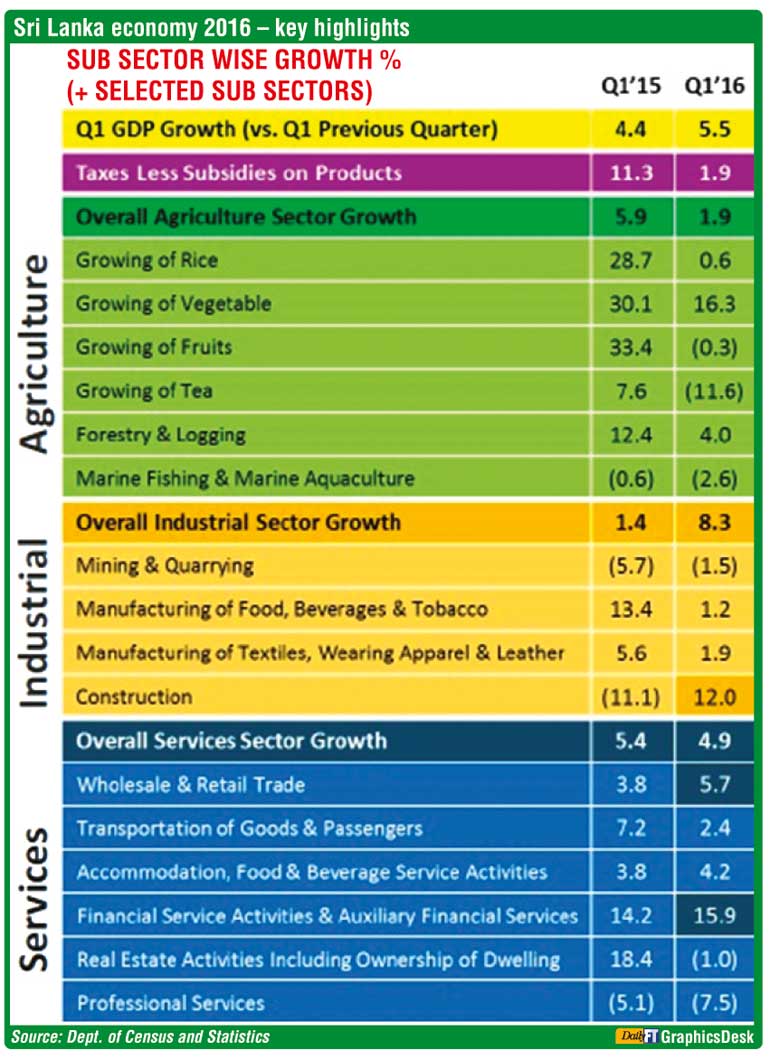Wednesday Apr 16, 2025
Wednesday Apr 16, 2025
Tuesday, 18 October 2016 00:02 - - {{hitsCtrl.values.hits}}
 Sri Lanka’s handloom industry has carved out a niche in the global market
Sri Lanka’s handloom industry has carved out a niche in the global market
As a former Chairman of the Sri Lanka Export Development Board and serving the Board of the EDB for almost five years, I was elated that the hierarchy of the country was giving attention to the export development agenda, with the Prime Minister personally taking wing to Brussels to negotiate on the GSP+ facility and the initiatives that can spruce up Sri Lanka’s export performance.
The fallout of Brexit and the negative comments by US presidential nominee Donald Trump on integrating the world further adds pressure to the depressed global economy.
The US economy, forecasted to be in trouble with debt touching 10% of the economy and 11 million households facing the impact of the housing bubble burst, has yet registered an export growth of 54% in the first quarter which is interesting. This is interesting but needs to be carefully analysed as the risk element is high in this market. The good news is that Sri Lankan exporters focusing on the Asian market for growth, like the strong thrust into the Chinese markets, adds lustre to an area that is very challenging.
A point to note from a Sri Lanka economic perspective is that Sri Lanka’s challenge is more a supply chain issue than demand mix related. Overall production is down on many fronts be it fruits, fish or mining/quarrying, just to name a few.
If one analyses the performance of strong export growth economies like China and Bangladesh, the strength of this industry is demonstrated, which has withstood the aggressive competitors and driven export performance even without trade incentives like GSP Plus, which clearly signals to the world the power of the product and business equity it has accumulated over time specially in the supply chain.
There are classic examples like Ceylon Tea, which announced to the world the proposition of the first ozone friendly tea, has shot up to 20.9% growth in quarter one, against all odds in the supply chain must examine it as the best practice to my mind. But the wage bill crossing to Rs. 1,000 if the current lobbying works will sure make the Net Sales Average (NSA) beat the Cost of Production (COP) as already the two lines are converging.
The sad saga is that most of the reports done by expert panels on how Sri Lanka’s tea industry can be made competitive continue to gather dust which included the report by the 10-man committee appointed by the President which has not been taken off the shelves and has been in the system for almost four years.
Whilst many countries around the world are driving exports strategy on the ethos of value chain development, a new business plain unfolding is the concept called ‘network chain development,’ which is centred around the capability set of a country.
Whilst different names are being assigned by academic entrepreneurs, in simple words this practice means a country’s capabilities are extended to cover a new range of products so that a small share of the global export business can be captured. The good news is that Sri Lanka has already latched on this concept.
For instance the handloom weavers have been trained on soft-toy stitching with expert training being provided by global experts. But a point to note is that countries that are into this new ethos of driving development have embarked on projects that are large and can make a stronger impact on the export numbers.
Whilst there are many limitations to this practice, like economies of scale and the theory of comparative advantage, the fact is that  it is been practiced successfully by countries like Malaysia and South Korea and they have been successful in revving up export growth, breaking the cycle of organic growth.
it is been practiced successfully by countries like Malaysia and South Korea and they have been successful in revving up export growth, breaking the cycle of organic growth.
A country that pursues this strategy moves away from subsidies and credit schemes to more hardwired offerings like focused industrial zones which are coupled with employment targets and foreign exchange value targets. But this is being pursued together with a strong Government backing for infrastructure development that includes water, electricity, manpower, roads, sewerage systems and IT enabling services.
The best case in point is the Tamil Nadu State, which houses 227 manufacturing operations from the top 500 global companies. When I last met the Secretary to the Ministry of Industries of the Tamil Nadu Government, his proposition was that Tamil Nadu must have own ranking in the Global Competitiveness Report and must not be clustered under India. This signals to the world the power in which the economy is being unleashed and driven for growth.
This approach of driving value chain development has been specialised by a Harvard Professor and Nobel Prize winning nominee who has just been appointed to consult to the Government of India. He has developed a mechanism that overlays the capabilities set of a country with the existing product range and then recommends the new product range that can be developed in a country which can use the same capabilities set. As mentioned before it is termed value chain development. However, he warned that unless ruthless policy decisions are enacted and implemented, this strategy will just remain an academic exercise.
Once again the good news is that Sri Lanka has a good track of taking drastic policy decisions in the past like when the apparel industry was launched way back in the 1980s, but what is mandatory is a strong political backing to drive these changes into the system. One country that has successfully done it in the recent past is Ghana in the African continent to be specific. I guess Sri Lanka can evaluate this strategy and chalk out a strategy of developing an operational agenda.

Moving on from this macro new fashion that is evolving of network chain development, let me share 10 key insights that can spruce up exports in a country and drive the development agenda.
Do not fight on price. Offer something distinctive and unique that challenges a consumer to switch to your product. This can be technology driven like the zero carbon bras or the single piece bra that the apparel industry of Sri Lanka highlighted or it can be a single-minded proposition like ozone friendly tea from Sri Lanka but the logic is that it must be a strong proposition to the consumer and not for us manufacturing it.
Do not spread your resources over many geographical boundaries. Stick to a few but build strong linkages with the demand chain. The best example to us in Sri Lanka is a renowned brand of papadam which focuses on the Saudi Arabian market and has developed a range of products in different colours and taste. It is the number one pick in that market. In fact during the holy season of Ramadan, the exporter holds a special function at the break of fasting that has become a social event in Saudi Arabia.
3. Linkage
In some markets rather than brands, the distribution pipelines build brands. Though it’s not ideal, it’s the reality and let’s accept it. Be very slow in selecting the distributor and also be extra careful in managing this relationship.
I know of a CEO in the tea industry who personally manages the key six buyers and will not even delegate it to one’s own family members. Hence the CEO is the salesman, brand manager, finance head and logistics manager. I guess this is what it takes to win in today’s world.
4. Airplanes
You cannot build a business with desk research. You have to get on the next plane and walk the streets. The best insight to consumer behaviour comes from face-to-face ground reality checks. I know of a Sri Lankan exporter who built a striving business in Kenya selling refuse tea as fertiliser. Such business insights cannot be sought through secondary data analysis.
It has become imperative that one is multilingual-skilled. It can be the different dialects of Chinese or the fluency of Spanish or French, the logic being that language fosters strong relationships.
At the end of the day its relationships that keep business and not strong brands. It is the reality and we have to accept it. The best case in point is how Sri Lankan Ayurvedic products have entered the Asian countries that already have a heritage in this sector of business. Relationships drive business.
Local premises are a must in today’s entrenched business arena. But do not do it too fast. A better option is to station an own company staffer in the overseas market. Start by housing the person at the distributor’s office and once the business is breaking even, move to an independent location. Many companies which operate the Indian market use this approach.
All top exporters have been an SME at one time in their life. Stick to the knitting and keep working on shaping your product to the international consumer so that a critical mass can be achieved. Thereafter, you can get into the sexy strategies of brand marketing. But until then, stick to a basic product and maintain supply consistency. This is where many Sri Lankan exporters falter.
If you can get a local investor to the company, do it. It’s a sure win to stabilise the business and reduce the risk. Especially in the Middle Eastern countries practice it, given the uprising and uncertainty in the market place.
Avoid consultants to do your business. Engage people who will be accountable for their initiatives. The complexity of the global market place can only solved by hands-on leadership. I have noticed that people with sales experience do well in the export marketing game.
It’s good to visit your business partners but more importantly make time to meet your end consumer. Try to develop a consumer panel so that you can meet a cluster of consumers over lunch on a regular basis. A leading toy manufacturer embarks on this strategy and it has helped understand changing consumer tastes.
Discover Kapruka, the leading online shopping platform in Sri Lanka, where you can conveniently send Gifts and Flowers to your loved ones for any event including Valentine ’s Day. Explore a wide range of popular Shopping Categories on Kapruka, including Toys, Groceries, Electronics, Birthday Cakes, Fruits, Chocolates, Flower Bouquets, Clothing, Watches, Lingerie, Gift Sets and Jewellery. Also if you’re interested in selling with Kapruka, Partner Central by Kapruka is the best solution to start with. Moreover, through Kapruka Global Shop, you can also enjoy the convenience of purchasing products from renowned platforms like Amazon and eBay and have them delivered to Sri Lanka.
Discover Kapruka, the leading online shopping platform in Sri Lanka, where you can conveniently send Gifts and Flowers to your loved ones for any event including Valentine ’s Day. Explore a wide range of popular Shopping Categories on Kapruka, including Toys, Groceries, Electronics, Birthday Cakes, Fruits, Chocolates, Flower Bouquets, Clothing, Watches, Lingerie, Gift Sets and Jewellery. Also if you’re interested in selling with Kapruka, Partner Central by Kapruka is the best solution to start with. Moreover, through Kapruka Global Shop, you can also enjoy the convenience of purchasing products from renowned platforms like Amazon and eBay and have them delivered to Sri Lanka.